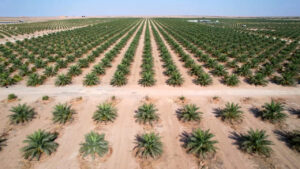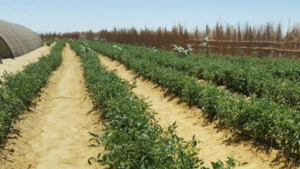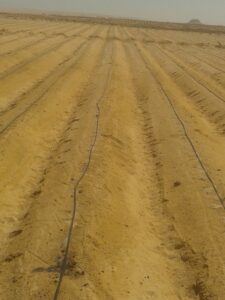Land reclamation
Land reclamation is one of the most important projects we work on, as we aim to transform unused lands into productive agricultural lands. Egypt faces major challenges in this area, including the shortage of arable agricultural lands and the high population. Therefore, we consider land reclamation an essential part of our strategy to achieve food security.
We rely on advanced technologies in land reclamation, such as modern irrigation systems that ensure efficient water distribution, which reduces waste and increases productivity. We also use environmental fertilizers and sustainable agricultural techniques to ensure long-term production continuity.
Reclaiming desert lands and converting them into arable lands requires following a set of methodological steps. The following are the main steps that include feasibility studies, land preparation, and other stages:
1. Feasibility study
- Site analysis: Studying geographical, climatic, and soil characteristics.
- Resource assessment: Identifying available water sources and other resources (such as energy).
- Market study: Analyzing the demand for potential crops and agricultural products.
- Costs and returns: Estimating the total costs and expected returns from the project.
2. Land preparation
- Land cleaning: removing stones and harmful plants.
- Land leveling: using heavy equipment to level the soil and ensure water drainage.
3. Well drilling
- Determining well locations: based on a water resources study.
- Well drilling: using appropriate drilling equipment to extract groundwater.
- Well preparation: installing pumps and filtration systems to ensure water quality.
4. Irrigation network extension
- Irrigation system design: choosing the appropriate irrigation system (such as drip irrigation or sprinkler irrigation).
- Network implementation: installing pipes, valves and necessary stations.
5. Using the latest technology tools
- Smart agriculture technology: using sensors to monitor humidity and temperature.
- Agricultural software: using programs to analyze agricultural data and improve productivity.
- Modern equipment: such as smart agricultural machines and drones to monitor crops.

6. Starting to level the land
- Final leveling: Ensure that the land is well leveled to facilitate irrigation.
- Soil improvement: Add organic fertilizer or nutrients to improve soil fertility.
7. Starting to plant
- Crop selection: Identify crops suitable for the local climate and soil.
- Planting seeds: Carry out the planting process using appropriate techniques (such as direct planting).
- Crop care: Provide the necessary care for the plants, including irrigation, fertilization, and biological control of diseases and pests.
8. Follow-up and evaluation
- Growth monitoring: Monitoring the progress of crops and evaluating the results.
- Adjustments and development: Making the necessary adjustments based on the performance evaluation.
Using these steps, successful reclamation of desert lands can be achieved and transformed into productive agricultural areas.



















